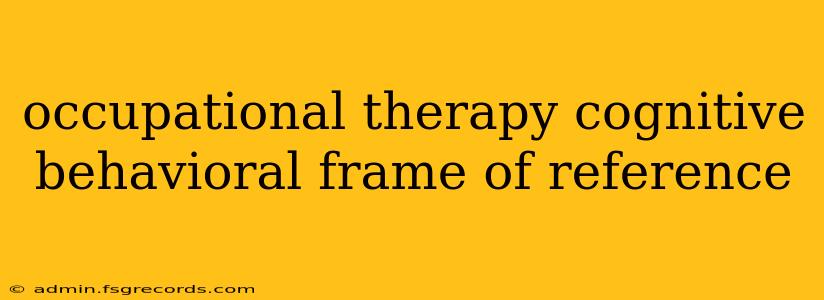Occupational therapy (OT) aims to help individuals participate in meaningful activities. One powerful tool in an OT's arsenal is the Cognitive Behavioral Frame of Reference (CBF). This framework offers a structured approach to understanding and addressing the cognitive and behavioral factors that impact a person's ability to engage in occupation. This post will explore how the CBF is used in occupational therapy, its key principles, and its application across diverse populations.
Understanding the Cognitive Behavioral Frame of Reference in OT
The CBF in occupational therapy rests on the idea that our thoughts, feelings, and behaviors are interconnected. Negative or unhelpful thought patterns can lead to maladaptive behaviors that interfere with daily life and occupational performance. The goal of using the CBF is to help clients identify these patterns, challenge their validity, and develop more adaptive coping mechanisms. This isn't about simply changing behavior; it's about changing the underlying beliefs and thought processes that drive those behaviors.
Core Principles of the CBF in Occupational Therapy:
- Cognitive Restructuring: This involves identifying and challenging negative or distorted thought patterns (e.g., catastrophizing, all-or-nothing thinking). The OT helps the client replace these thoughts with more realistic and positive ones.
- Behavioral Activation: This focuses on encouraging participation in activities that are enjoyable and rewarding. Even small successes can build confidence and motivation, creating a positive feedback loop.
- Problem-Solving: The CBF helps clients develop structured approaches to problem-solving, breaking down complex challenges into manageable steps. This empowers clients to feel more in control and less overwhelmed.
- Self-Monitoring: Tracking thoughts, feelings, and behaviors allows clients to identify patterns and triggers, providing valuable insight into their occupational performance.
- Relaxation Techniques: Stress management techniques, such as deep breathing or progressive muscle relaxation, are incorporated to manage anxiety and improve overall well-being.
Applying the CBF Across Diverse Populations
The CBF's versatility makes it applicable to a wide range of client populations and occupational challenges. Here are some examples:
1. Mental Health:
Clients with anxiety, depression, or other mental health conditions often benefit greatly from the CBF. It can help them manage symptoms, improve coping skills, and increase participation in daily activities. For instance, an OT might use CBT techniques to help a client with social anxiety gradually re-engage in social situations.
2. Neurological Conditions:
Individuals with traumatic brain injury (TBI), stroke, or other neurological conditions may experience cognitive impairments affecting their ability to perform daily tasks. The CBF can help these clients improve attention, memory, and problem-solving skills, facilitating their return to valued occupations. A structured approach to task completion can significantly improve performance.
3. Physical Disabilities:
Even clients with physical limitations can benefit from the CBF's focus on cognitive strategies. For example, someone with arthritis might use cognitive restructuring to manage pain and frustration, enabling them to maintain their independence in self-care tasks. Adjusting expectations and focusing on achievable goals are key elements in this approach.
4. Pediatric Populations:
The CBF is increasingly used with children and adolescents facing challenges in areas such as sensory processing, self-regulation, or social skills. Play-based interventions incorporating CBT principles can be highly effective in fostering adaptive behaviors and improving occupational performance in young clients.
The Role of the Occupational Therapist
The OT plays a crucial role in implementing the CBF. They act as guides and facilitators, helping clients to:
- Identify maladaptive thought patterns and behaviors.
- Develop and practice new coping strategies.
- Set realistic goals and monitor progress.
- Generalize skills learned in therapy to real-life situations.
Conclusion: A Holistic Approach to Occupational Performance
The Cognitive Behavioral Frame of Reference offers a valuable and holistic approach to occupational therapy. By addressing the interplay between thoughts, feelings, and behaviors, OTs using the CBF empower clients to overcome challenges, improve their occupational performance, and participate more fully in life. Its adaptability makes it a cornerstone of evidence-based practice across numerous settings and client populations. The future of occupational therapy undoubtedly includes a continued exploration and refinement of the CBF's applications, further solidifying its importance in improving the lives of countless individuals.

